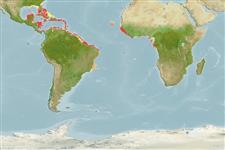Common names from other countries
Classification / Names / Names
Nomi Comuni | Sinonimi | Catalog of Fishes (gen., sp.) | ITIS | CoL | WoRMS
Environment: milieu / climate zone / depth range / distribution range
Ecologia
Associati a barriera corallina; distribuzione batimetrica 0 - 30 m (Ref. 848). Subtropical; 33°N - 25°S, 92°W - 12°E (Ref. 848)
Atlantic Ocean.
Length at first maturity / Size / Peso / Age
Maturity: Lm ? range ? - ? cm Max length : 5.0 cm COLD maschio/sesso non determinato; (Ref. )
Colony: small, usually less than 50 mm across, hemispherical to encrusting. Corallites: shape range from immersed to conical to tubular, may be circular with one mouth, to elongate with multiple mouths; intertidal encrusting colonies may be submeandroid; spherical colonies with unrestricted growing space often with tubular corallites; valleys seldom more than 5 mm across; walls neatly rounded, whatever the corallite shape. Septo-costae exsert and evenly spaced. Color: often tan to light orange-brown with pale green tentacles (Ref. 848).
Zooxanthellate (Ref. 116012). Common in shallow less than 15 m; reef habitats and sometimes seagrass beds (Ref. 415). Also in intertidal rock pools and shallow reef environments (Ref. 848).
Life cycle and mating behavior
Maturità | Riproduzione | Deposizione | Uova | Fecundity | Larve
Hermaphroditic (Ref. 113712). Mature gametes are shed into the coelenteron and spawned through the mouth. Life cycle: The zygote develops into a planktonic planula larva. Metamorphosis begins with early morphogenesis of tentacles, septa and pharynx before larval settlement on the aboral end (Ref. 833).
Collin, R., M.C. Díaz, J. Norenburg, R.M. Rocha, J.A. Sánchez, M. Schulze, A. Schwartz and A. Valdés. 2005. (Ref. 415)
IUCN Red List Status (Ref. 130435)
CITES status (Ref. 108899)
Not Evaluated
Human uses
| FishSource |
Strumenti
Informazioni ulteriori
Age/SizeAccrescimentoLength-weightLength-lengthMorfologiaLarveAbbondanza
Fonti Internet
Estimates based on models
Preferred temperature
(Ref.
115969): 26.2 - 28.1, mean 27.5 (based on 798 cells).
Price category
Unknown.
